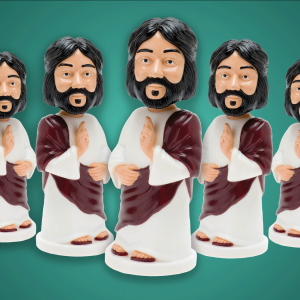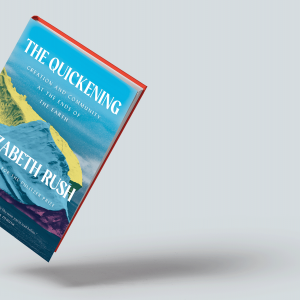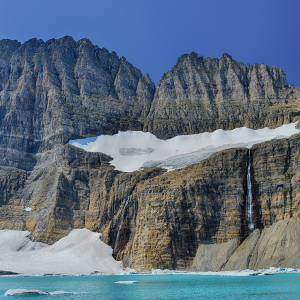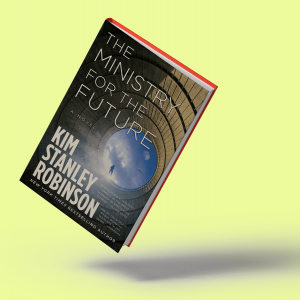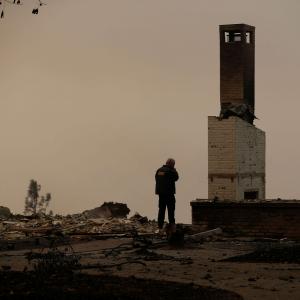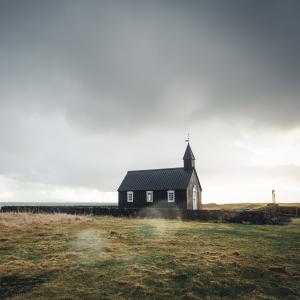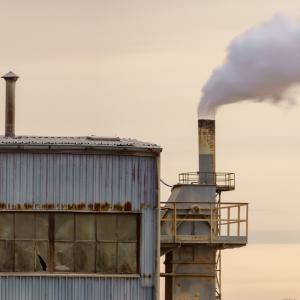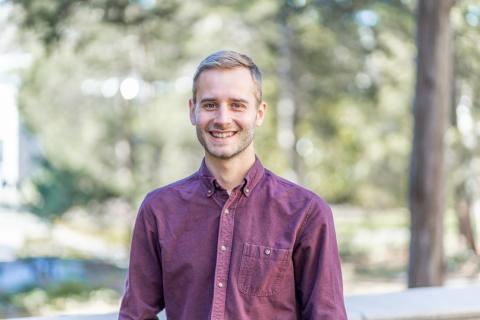
Avery Davis Lamb is an activist, ecologist, and public theologian working at the intersection of Christianity and environmental justice. He is the co-executive director of Creation Justice Ministries, whose mission is to educate, equip and mobilize Christians to protect, restore, and rightly share God's creation.
Avery has a background in both ecological research and faith-based environmental organizing, studying ecology in various ecosystems and organizing faith communities across the country in support of action on environmental justice. He serves on the board for The Center for Spirituality in Nature and is a Fellow with the Re:Generate Program at Wake Forest Divinity School and the Foundations of Christian Leadership Program at Duke Divinity School.
Posts By This Author
Robin Wall Kimmerer Believes Our Economic Scarcity Is Manufactured
A BRAID OF sweetgrass sits next to my laptop. When I get overwhelmed by an endless to-do list or the weight of living in the Anthropocene, I run the strands through my fingers like prayer beads and bring the braid to my nose. Big breath in. Big breath out. Even after years of doing this, the scent carries a grounding sweetness, reminding me of something deep and good.
In her iconic book Braiding Sweetgrass, Robin Wall Kimmerer, an enrolled member of the Citizen Potawatomi nation and professor of environmental biology, writes that when you take in the scent of the sweetgrass, or wiingaashk in Ojibwe, you “start to remember things you didn’t know you’d forgotten.”
In her latest slim volume of essays, The Serviceberry, Kimmerer helps us remember what we have clearly forgotten: The world is a gift, and there is plenty of the world for everyone and everything.
Known for its beautiful white blossoms and abundant, nutty-tasting fruits, the serviceberry, also called juneberry, is named bozakmin in Potawatomi, meaning “the best of the berries.” To Kimmerer, the serviceberry is the embodiment of the gift economy. “In a serviceberry economy, I accept the gift from the tree and then spread that gift around, with a dish of berries to my neighbor, who makes a pie to share with his friend, who feels so wealthy in food and friendship that he volunteers at the food pantry,” Kimmerer writes. “To name the world as gift is to feel your membership in the web of reciprocity.”
Bobble-Head Jesus Is Not the Living Christ
DESPITE WHAT DASHBOARD Jesus figurines might suggest, there is no plastic in the Bible. None. It’s a 100 percent plastic-free zone. Jesus does, however, promise eternal life. While Christians have a wide array of interpretations about what that means, we generally agree that Jesus did not mean through polyresins and microplastics, which have a nearly eternal life of their own.
Christians are on the forefront of the battle to reduce fossil fuel use and address climate change. We understand that God has given us a mandate to serve and protect the Earth and its communities. Churches have divested from fossil fuels. Christians have risked arrest for effective legislation. Youth are leading the global defense of our planet and people.
But, as the pressure to transition to renewable energy increases and fossil fuel demand drops, the CEOs of petrochemicals want to keep their money pipelines open.
Over the past 70 years, annual production of plastics has increased nearly 230-fold, reaching 460 million tons in 2019. China, with weak human rights and environmental regulations, is now the world’s largest plastics manufacturer, accounting for nearly one-third of global production. If trends in oil consumption and plastics production continue at the current rate, plastics will make up 20 percent of fossil fuel consumption by 2050.
Studies track with increasing accuracy the total mass of microplastics found in adults around the world. It’s a lot. You may as well just chew on your credit card. Microplastics are linked with a variety of human health issues, including reproductive disorders, organ damage, and developmental impacts on children.
Is Giving Birth in a Time of Climate Change Hopeful or Fatal?
IN THE QUICKENING: Creation and Community at the Ends of the Earth, Elizabeth Rush explores both the quickening in her own body — the first feeling of the life moving in her belly — and the quickening pace of climate change.
In 2019, Rush embarked on a scientific sea-bound expedition to Thwaites Glacier in Antarctica, a writer among dozens of scientists. Their journey, via an icebreaker ship, was the first of its kind, bringing together geologists, paleoclimatologists, oceanographers, and a dozen other flavors of scientists to better understand how climate change is affecting a glacier at the end of the world.
Thwaites Glacier is enormous, bigger than the state of Florida and up to 4,000 feet thick. Because of its sheer size and vulnerability to collapse under warming, Thwaites is often referred to as the “Doomsday Glacier.” This one glacier contributes to about 4 percent of global sea-level rise, and whenever it collapses, it will cause global sea levels to increase by more than two feet.
Baptized in the Meltwater of a Dying Glacier
I KNOW WHAT it’s like to be baptized in the meltwater of a dying glacier. It feels like a plunge into all the emotions of living in our climate-changed world: joy, dread, awe, fear, love.
In August, a few of my college friends and I took a trip, something of a pilgrimage, to Glacier National Park in Montana. We wanted to visit the glaciers that are projected to die off in the coming decades. The Kootenai people call this place Ya·qawiswitxuki,“the place where there is a lot of ice.” It is a place burdened with names that it will hold on to even after the glaciers and ice disappear.
The geology of the park is like a cake cut open to show layers of sandstone, shale, and limestone — a portal into deep time. About 100 million years ago, in an event called the Sevier Orogeny, the mountains in Glacier formed as the forces of colliding tectonic plates thrust two billion years’ worth of sedimentary rock upward. Across 100,000-year cycles, glaciers formed and retreated, slowly whittling away at the rock and carving out dramatic valleys, moraines, arêtes and horns, cirques and tarns. During a simple four-hour hike, we walked through billions of years of sedimentation.
Walking through such a place makes this moment in history seem both insignificant and deeply important. Thousands of feet of layered sediment formed organically, with nearly no human influence, but the small sliver at the top will be markedly human. This Anthropocene layer in the geologic cake holds markers of nuclear bombs, cow manure, and a lot of plastic. It holds the most dramatic increase in carbon concentration and the accompanying increase in temperature. It holds the extinction of hundreds of creatures, which may soon include the western glacier stonefly and meltwater lednian stonefly, who require ice-cold clear streams to survive.
This layer is also the moment, a blink of an eye in geologic time, when the mighty glaciers disappear. It is estimated that by 2100, two-thirds of the world’s glaciers will be killed. The reality is more devastating in the eponymous national park, where all the glaciers are expected to be gone by the end of this century. I can’t predict all the impacts the park will feel over the next 75 years, but I imagine that the numerous hikers currently making pilgrimages to the glaciers will instead walk in funeral processions to plaques, like the one marking the death of the Okjökull Glacier in Iceland.
Resting Where God’s Presence Unfolds Like the Fiddlehead Fern
Despair blossomed in me; my fears of what my life and the lives of future generations could become seem to be coming true. I take my bouquet of despair to the only place big enough to embrace it: the body of Creation. I set it before the altar of the water and soil.
Skip ‘Jurassic Park.’ Watch ‘Prehistoric Planet’ Instead
The new series Prehistoric Planet offers a vision of Cretaceous life; a world filled with life completely different from our own, yet on this same planet. In a time when life is precarious and extinction all around, our prehistoric predecessors offer some comfort and not a little bit of escape.
‘Blah, Blah, Blah.’ Will COP26 Actually Lead to Climate Action?
Starting Oct. 31, world leaders will gather in Scotland to negotiate the terms of our future. This United Nations climate change conference, called COP26, is an opportunity for leaders to flaunt their climate actions ambition — no leader more so than President Joe Biden, who plans to attend with nearly half his cabinet. This is a show of force from the White House, an indication that political winds have shifted and the United States is prepared to be a global climate leader.
Hope Is a Climate Survival Strategy
This week, the United Nations Intergovernmental Panel on Climate Change (IPCC) released a report on the state of the climate crisis. It is a report that frames, in the cautious language of science, the dire state of the world. This panel of experts from around the world found that warming of 1.5 to 2 degrees Celsius in the next century is certain unless there are extreme and immediate cuts in greenhouse gases. This level of warming would spread and intensify the kinds of extreme weather — hurricanes, wildfires, floods, and heat waves — we have seen unfold for over a decade. This report shows us the reality that our actions will not be enough to prevent catastrophic climate change. Immediate action on climate can prevent the worst effects of climate change — but catastrophe has already happened. Catastrophes are happening all around us.
Persevering Despite the Profound Depth of the Climate Crisis
IT BEGINS IN the way the 2020s could end: with a climate change-driven heat wave that kills 20 million people in India. Kim Stanley Robinson’s work of science fiction is heavy on the science and light on the fiction. Indeed, the “fiction” of this novel reads more prophetic than futuristic. Just like biblical prophets, Robinson is less interested in predicting a far-off world than seeing our current world for what it is. The words of the prophet Jeremiah would fit snugly in this book: “Disaster overtakes disaster, the whole land is laid waste” (4:20).
Robinson’s vision of a response to climate change veers on the edge of technological utopianism without ever falling into the abyss. The airships, cryptocurrencies, and drones of Robinson’s novel are not simply fantastic simulations of a utopian (or dystopian) world. They are pragmatic responses to a world that is burning and melting under our feet. While the need for technological solutions is so apparent in Ministry (and in our own world), Robinson’s hope is not located in technology. Rather, the tentative hope of Ministry is found in the unwavering humanity of its many heroes.
Liberation Starts at the Table
2020 WAS A YEAR of ecological breakdown. Simultaneous climate disasters have roared, including the worst wildfire season in the history of California and, as I write this, the most active hurricane season on record in the Atlantic. Meanwhile, freak wind storms called derechos plagued the Midwest and heatwaves baked the Southwest. In the midst of such devastation, it can seem downright irresponsible to search for hope. Yet, the paradoxical call of the cross is that, in the deepest darkness, joyful and beautiful transformation might be possible.
In The Green Good News, T. Wilson Dickinson does not settle for platitudes of hope. He does not affirm, as is so tempting for Christians, that all will be fine because of faith in God. Instead, Dickinson finds good news in the possibility of a beautiful and joyful set of responses to ecological breakdown. With humble writing grounded in stories of his own life, Dickinson offers a reading of scripture that does not separate the liberation of creation from the liberation of the poor but follows the vision of Jesus, in whom all creation—human and more-than-human—holds together. In a refreshing move, The Green Good News sheds the romanticism of creation care in favor of a biblically based environmental justice from the margins. Dickinson unequivocally offers a call to conversion from neoliberalism to solidarity with all oppressed creatures. This ecological conversion takes place at the heart of the Christian witness: the table.
Beyond Human Nature
WHILE THE CLIMATE crisis has reconfigured our relationships with each other, other creatures, and our places, fiction has not. It remains focused on the human’s internal, moral journey, as if human life is something circumscribed from the rest of creaturely life. Gun Island is a much-needed antidote to the anthropocentric ideal of the novel, one that meets the age of climate change with stories that are true to the new dimensions of relationships unfolding around us.
In his first novel since his nonfiction masterpiece The Great Derangement, in which he laid out a vision for a climate-changed literature, Ghosh illustrates the agency of nature: how in this Anthropocene age, shaped by human activity, our porous lives are intertwined with those of our nonhuman interlocutors, who become increasingly present in our lives through climate-change-driven typhoons, fires, and species migration. He tells a story of stories, not recasting the tales of modernity, but reaching back into Bengali folklore to guide us through this uncanny age. For, as one of Gun Island’s characters says, “Only through stories can invisible or inarticulate or silent beings speak to us; it is they who allow the past to reach out to us.”
How Three Coastal Churches Became Hubs of Climate Resilience
WE DO NOT need another litany of climate disaster. What we need are stories of climate resilience—communities responding to the physical and spiritual needs wrought by climate collapse. For millions of people, those needs are brought by floodwaters inundating communities with rain and rising tides. And as waters rise, some churches also rise to generate spiritual and physical resilience, reimagining their land, mission, and ministry for the age of climate change. According to these congregations, climate action is not a deviation from the mission of the church; it’s the only way to remain true to the message of the gospel when floodwaters are rushing into our houses and sanctuaries.
Flow, river, flow
WERE IT NOT for the “Shrove Tuesday Pancake Dinner Tonight!” banner and obligatory “Episcopal church in 1 mile” sign, you could drive past St. Luke’s Episcopal Church and miss the building entirely. Obscured behind a line of oaks and a hillock of native hydrangea, the sanctuary almost disappears into the landscape. For Rev. Diana Carroll, that’s the hope.
When Carroll moved to Annapolis, Md., in 2012 to serve St. Luke’s, the four acres behind the church, which abuts Back Creek, a tributary of the Chesapeake, were a tangled mess of brush. The church had planned to clear that land to build a large sanctuary and convert the current structure into an education building, but Carroll and members of the St. Luke’s Green Team suggested St. Luke’s keep its current sanctuary and use the five acres as “a sanctuary without walls.” As Carroll envisioned it, if the church restored the land, it would still be “a sacred space as had always been dreamed about for that location.”
For years, St. Luke’s has been involved in climate action, integrating climate literacy into its preaching and education while advocating for stronger climate policy at the Maryland State House. So in 2017, when the 120-person congregation received a total of nearly $2 million in grants—largely from the Maryland Department of Natural Resources and the Chesapeake Bay Trust, plus small grants and donations through the church—to restore wetlands and a buried stream on their property that drained into Back Creek, they realized the project was a physical expression of their commitment to earthkeeping. With the help of an ecological restoration company, they coaxed back to the surface the stream that had been diverted through stormwater pipes and built a cascading streambed, with step pools and weirs—low dams to slow water flow—to filter the water as it makes its way toward Back Creek. They named the restored stream Bowen’s Branch, after a late congregant who cared deeply about watershed stewardship in Annapolis.
When I visited St. Luke’s in 2019, Carroll and I followed the curve of the stream to its mouth, which is now a living shoreline, a small coastal edge made of native plants and natural materials rather than a concrete seawall. In an age of climate crisis, marshes like this one are critical: As sea levels rise, marshes engage in a kind of dance with the rising tides through a process called accretion. This is especially important in a place like Annapolis, where waters breaching sea walls and submerging parking lots, roads, and sidewalks has become a frequent problem (only four such events were recorded in the early 1960s, compared to 63 in 2017). When the dock in downtown Annapolis floods, explained Carroll, the church’s marsh helps absorb the extra water. The marsh is also a carbon sink, more effective at sequestering carbon than the equivalent area of dry land.
By restoring their land to serve its intended purpose, the church created a climate sanctuary: absorbing higher tides, filtering polluted stormwater from extreme rain events, hosting displaced creatures, and drawing carbon out of the air. And while St. Luke’s sanctuary is high enough above sea level to be outside the floodplain, the same is not true for all Annapolis residents. The church is in solidarity with those neighbors, absorbing the water their houses cannot, holding a space for lament when devastation comes, and advocating for equitable climate solutions—an ecotone where the meditative ebb of human action meets the flow of steadily rising tides.
Amazon Fires Are Like Arson in God's Cathedral
What we need now is to #PrayfortheAmazon — to lament the devastation to the creatures and to our climate. We need to talk about the loss in our churches, singing and praying in community. Then we need to have the courage to mobilize and save what’s left of this beautiful world.
Our Ethical Structure
IN HIS ESSAY “The Land Ethic,” environmentalist Aldo Leopold tells a story from The Odyssey in which Odysseus, upon returning to Troy, hangs a dozen slave girls for misbehaving in his absence. The act, Leopold writes, was not one of ethics but of property: “The ethical structure of that day ... had not yet been extended to human chattels.” Leopold uses this as an example of how our ethical structure has expanded over history. This expansion of the moral circle is a common thread in history, encompassing, slowly, people and things that were once outside moral consideration.
Faith Communities Hold World Leaders Accountable at U.N. Climate Negotiations
The United Nations climate negotiations in Katowice, Poland — the follow-up to the blockbuster 2015 Paris conference — came to a dramatic close on Dec. 15 with the adoption of the "Katowice Climate Package." The package represents significant progress on global climate action and will allow nations to move forward in setting and meeting greenhouse gas emissions reduction targets over the next five years. However, the roadmap will need major improvements to reach the level of “ambition” the scientific community says is needed to protect the most vulnerable.
Denying Climate Change Is Not Just Political — It's Deadly
A dystopian scene is unfolding across California. Charred car skeletons sit idle on the side of roads in the working-class town of Paradise, Calif. In one video, a camera pans to reveal what looks like an apocalyptic movie set — passing the remains of an abandoned school bus, begging us to ask what happened to those who were inside.
Breaking the Climate Silence in Our Sanctuaries
Climate change is a crisis of moral proportions. Rather than responding to the climate crisis with resignation or cynicism, our congregations can chart a new path forward by responding to this moral crisis in a distinctively religious way. By probing deeply into our religious traditions, we can present truths that are needed in this time of climate catastrophe.
Yes, Climate Change Is Terrifying. Here Are 6 Things to Give You Hope.
We will need both lament and hope to cope with the existential crisis of climate change. Go read New York Magazine writer David Wallace-Well’s piece for your dose of lament. Then read the stories below for a briefing on where to look for hope.
Science: A Sacred Resistance
It is crucial for Christians to be involved in this march and supportive of science. Our orientation to the world is to care for all creation, human and non-human. Science, when done humbly and rigorously, recognizing our creaturely place in creation, and seeking understanding over control, enables us to more fully care for the world and draw closer to God. The march for science is an opportunity to stand in solidarity with scientists whose work helps us better understand the world and care for the oppressed.
Trump Just Signed an Executive Order on the Environment. Here’s What You Need to Know.
The power of the order is found less in its immediate consequences, and more in its trajectory-setting results. While the world is slowly backing away from a crumbling cliff, this executive order represents a shift into drive to send the global climate hurtling toward the ledge.

